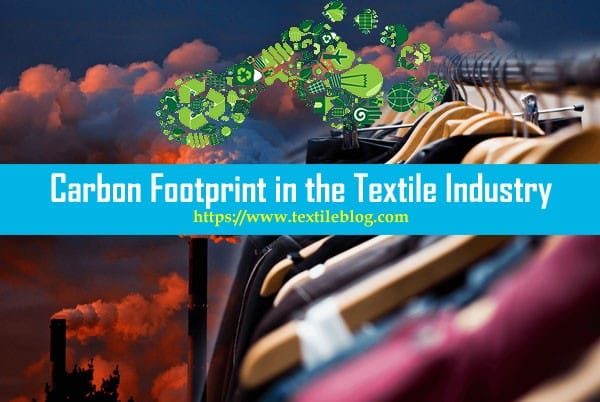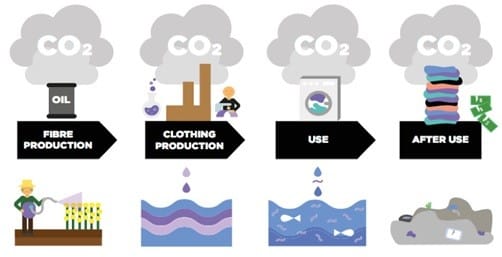What is Carbon Footprint?
Carbon footprint is a tool developed by the ADEME (the French Environment and Energy Management Agency) which measures the greenhouse gas emissions of a product. The measurement of a product’s carbon footprint is carried out over the entire life cycle of the same product. From the production of raw materials until its destruction (or recycling), rea product will create activity. Thanks to the carbon footprint, we can know the impact of these activities on the environment by evaluating the greenhouse gas emissions they generate. The activities in question are measured in carbon equivalent because, as you know, CO2 is the main greenhouse gas.

Always more clothes and less and less expensive. The success of ready-to-wear has revolutionized the way we buy clothes, but has made fashion one of the most polluting industries on the planet. For the first time, on the sidelines of the G7, thirty-two textile and apparel companies, from Adidas and Nike groups to Chanel and Prada, via H&M and Gap, decided to commit to reducing the carbon footprint of the ‘clothing. Friday 23 August, these fashion giants signed a “Fashion Pact” aiming to reach zero net carbon dioxide (CO2) emissions by 2050 and to switch to 100% energy renewable throughout the supply chain by 2030.
What does environmental impact mean exactly?
When we talk about environmental impact, we must already understand what we are measuring: most of the results and figures that we read on this subject relate mainly to the carbon footprint of the product: we consider today that the emission of greenhouse gases is the main source that modifies the functioning of our environment and our planet. The carbon footprint, given in kg of CO2 equivalent, is thus the quantity of greenhouse gases released by the system studied. For that reason reducing of carbon footprint is really important for environment.
But many other factors can be studied: consumption of fresh or human-supplied water, energy used from fossil resources, the imbalance of aquatic environments following toxic discharges (eutrophication), the toxicological impact on human etc.
How do you determine the environmental impact of an object?
In textiles, we know carbon footprint increased highly. A life cycle analysis therefore begins with the production / extraction of raw materials (cotton, polyester, etc.). It then includes the production phases of the garment, its use, and its end of life. The different points to remember about these different stages are:
- Raw materials: Cultivation of natural fibers, harvesting, and packaging. For synthetic fibers, extraction of petroleum and transformation to reach the thread.
- Manufacturing: Making of the fabric, manufacturing of the textile garment, taking into account the transport between each stage, as well as the waste generated
- Distribution: Product packaging, transport to the point of sale, energy consumption at points of sale
- Usage: Number of washing, drying and ironing cycles, etc.
- End of life: Incineration or recycling, associated transport

Amount of clothing per year for a European:
According to the European Environment Agency (EEA), the quantity of clothing purchased in the European Union (EU) increased by 40% between 1996 and 2012. In 2015, Europeans acquired 6.4 million tons of new clothes and shoes, according to a study by the European Parliament. Globally, the trend is the same: 100 billion clothes were consumed worldwide in 2014, according to Greenpeace. This consumption frenzy has experienced a jump since the 2000s. Day by day making hug quantity of cloths for that reason carbon footprint is increasing day by day.
This consumption hides strong disparities. If a North American buys an average of 16 kg of clothing per year, the figure reaches only 12.6 kg in the European Union and drops to just 2kg in the countries of the Middle East, according to Greenpeace . The demand for clothing is however increasing on the Asian and South American continents, according to the Ellen MacArthur Environmental Foundation. The French are in the low average in Europe, with 9 kg of clothes purchased per person per year, following a downward curve since the 1960s. According to the National Institute of Statistics and Economic Studies (INSEE), the household budget has been increasingly constrained by pre-committed expenses that are difficult to negotiate in the short term (rent, insurance and telephone contracts). Many French households have therefore reduced their purchases of clothing to compensate. The second-hand market has also established itself well in France after the economic crisis of 2008, contributing to the decrease in purchases in stores. There are so many steps and system we can reduce carbon footprint.
More accessible and faster fashion:
The first reason for this growing fashion craze: the rise of the middle classes in developing countries and the fall in clothing prices. With the development of ready-to-wear from the 1950s, then the numerous off shoring of textile production to countries with lower production costs, T-shirts at 5 Euro made their arrival on the shelves, allowing a growing middle class to consume more. This fast fashion generation we should think about how to reduce carbon footprint.
You may also like: Challenges in Sustainable Textile Recycling
Twenty-four collections per year in Zara stores:
In the early 2000s, fast fashion made its arrival. Some brands move from traditional spring-summer and fall-winter collections to ten collections a year. Zara even renews its departments twenty-four times each year. As a result, the lifespan of a garment has been cut in half over the past fifteen years, according to a study by the consulting company McKinsey. And almost a third of the wardrobe of Europeans has not been out of the closet for at least a year, according to the EEA.
Many garments therefore go into the trash. With recycling methods still ineffective, only 1% of the materials used to make clothes are used to make new ones, according to the Ellen MacArthur Foundation. In total, just under two-thirds of all global production ends up in landfills or incinerators, McKinsey estimates.
7,500 liters of water to make jeans:
The fashion industry is a major consumer of raw materials, especially cotton, which accounts for a quarter of world textile production. Its culture is not without consequences for the environment. A United Nations report estimates that 7,500 liters of water are needed to make jeans, the equivalent of water drunk by a human being for seven years.
Necessary at all stages of manufacturing a garment, water is also essential for applying dyes and chemicals. Ninety-three billion cubic meters of water is used each year by the textile and apparel industry, according to the Ellen MacArthur Foundation.
Another raw material, which we think less of, is essential to the fashion industry: petroleum, which is used in particular to make polyester. This synthetic fiber became, from the beginning of the 2000s, the most used material in ready-to-wear, because it is inexpensive and more resistant than cotton. This fossil resource is not renewable.
High greenhouse gas emissions:
The fashion industry produces significant greenhouse gas emissions. They are linked to the production of raw materials, through the breeding of cows, to produce leather, or of sheep, to produce wool. Added to this is the question of transporting textiles and finished products. It is mostly made by plane, the fastest means of transport, but a big producer of CO2, and over long distances, since the vast majority of clothes bought in the West are imported from Southeast Asia. The transportation of raw materials and finished products, however, only covers 2% of greenhouse gas emissions produced by the fashion industry, according to an estimate by the Ellen MacArthur Foundation. Fashion’s carbon footprint is particularly high due to the production of textiles. The manufacture of cotton, artificial and natural synthetic materials alone produces 1.2 billion tons of greenhouse gases, according to the environmental organization.
Carbon footprint – washing and micro plastics:
The biggest environmental impact of fashion is not linked to raw materials, production or transport, but to washing clothes. Both because of the water and energy used, increasing carbon footprint and also because of the water and soil pollution it causes.
Indeed, textile fibers contain chemicals, mainly detergents from laundry or perfumes, and micro plastics, contained in polyester or acrylic polymers. These particles are released into the oceans during washing and take decades to degrade. Over a third (35%) of the micro plastics released into the oceans come from washing textiles, according to the environmental organization the International Union for the Conservation of Nature (IUCN).
References:
- Handbook of Life Cycle Assessment (LCA) of Textiles and Clothing Edited by Subramanian Senthilkannan Muthu
- https://textilelearner.net/carbon-footprint-in-textile-industry/
- https://blog.hireahelper.com/how-to-seriously-lessen-your-carbon-footprints-when-you-move/
- https://www.co2nsensus.com/how-to-reduce-carbon-footprint-in-textile-industry
- https://www.researchgate.net/publication/276193965_Carbon_Footprint_of_Textile_and_Clothing_Products
- https://www.ecotextile.com/sponsored-content/reducing-the-carbon-footprint-in-textile-manufacturing.html
- https://textilevaluechain.in/2013/06/04/role-of-carbon-footprint-in-textile-and-apparel-industry/
- https://www.bsr.org/reports/BSR_Apparel_Supply_Chain_Carbon_Report.pdf
- https://mycourses.aalto.fi/pluginfile.php/558288/mod_folder/content/0/Group%203_Textile%20waste_paper%201.pdf?forcedownload=1
Author of this Article:
Md. Raisul Islam Rifat
Dept. of Textile Engineering
Daffodil International University, Dhaka
Email: ririfat750@gmail.com
